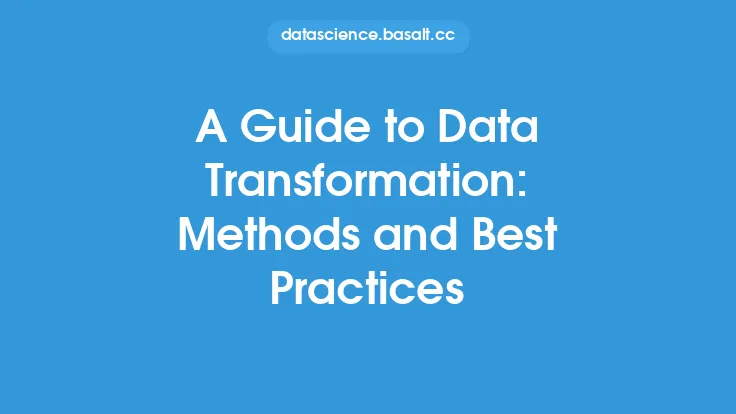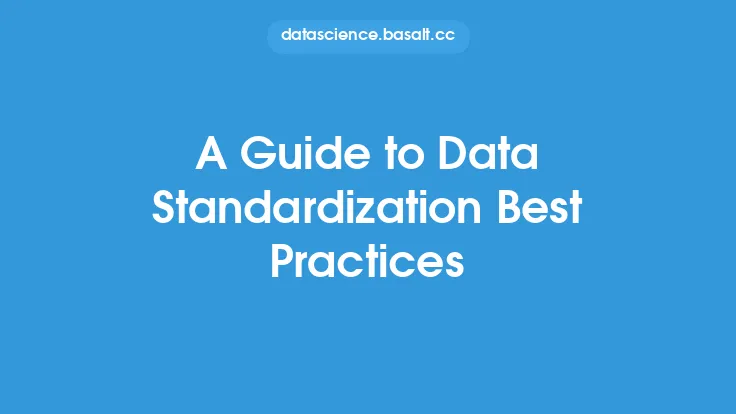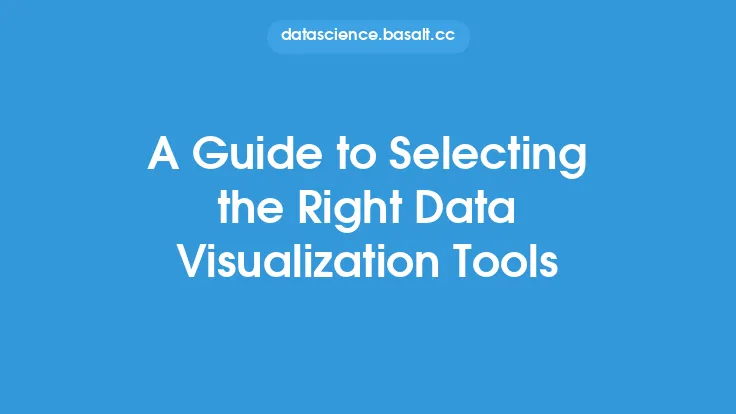Data visualization is a crucial step in the data analysis process, as it allows us to communicate complex data insights to both technical and non-technical stakeholders. Effective data visualization can help to identify trends, patterns, and correlations within the data, and can also facilitate the exploration and understanding of the data. In this article, we will discuss the best practices for data visualization, including the principles of effective visualization, the types of visualizations to use, and the tools and techniques for creating interactive and dynamic visualizations.
Introduction to Data Visualization Principles
The key to effective data visualization is to create visualizations that are clear, concise, and easy to understand. This can be achieved by following a set of principles that guide the creation of visualizations. The first principle is to keep it simple, avoiding clutter and unnecessary complexity. The second principle is to use a clear and consistent color scheme, avoiding the use of too many colors or colors that are too similar. The third principle is to use intuitive and interactive visualizations, allowing the user to explore the data in more detail. The fourth principle is to provide context, including labels, titles, and legends, to help the user understand the data. Finally, the fifth principle is to be honest and transparent, avoiding the use of misleading or deceptive visualizations.
Types of Data Visualizations
There are many different types of data visualizations, each with its own strengths and weaknesses. The most common types of visualizations include bar charts, line charts, scatter plots, and heat maps. Bar charts are useful for comparing categorical data, while line charts are useful for showing trends over time. Scatter plots are useful for showing the relationship between two continuous variables, while heat maps are useful for showing the relationship between two categorical variables. Other types of visualizations include histograms, box plots, and violin plots, which are useful for showing the distribution of a single variable. The choice of visualization will depend on the type of data and the story that you want to tell.
Best Practices for Creating Effective Visualizations
To create effective visualizations, there are several best practices to follow. The first best practice is to know your audience, tailoring the visualization to the needs and level of understanding of the user. The second best practice is to use a clear and consistent visual language, avoiding the use of ambiguous or confusing visual elements. The third best practice is to focus on the story, using the visualization to tell a clear and compelling story about the data. The fourth best practice is to use interactive visualizations, allowing the user to explore the data in more detail. The fifth best practice is to test and refine the visualization, soliciting feedback from users and making adjustments as needed.
Tools and Techniques for Data Visualization
There are many different tools and techniques available for data visualization, including programming languages such as R and Python, and visualization libraries such as D3.js and Matplotlib. These tools allow users to create a wide range of visualizations, from simple bar charts to complex interactive dashboards. Other tools and techniques include data visualization software such as Tableau and Power BI, which provide a user-friendly interface for creating visualizations. Additionally, there are many online resources and tutorials available for learning data visualization, including blogs, videos, and online courses.
Common Mistakes to Avoid in Data Visualization
There are several common mistakes to avoid in data visualization, including the use of misleading or deceptive visualizations, the failure to provide context, and the use of too much complexity or clutter. Other mistakes include the failure to consider the audience, the use of ambiguous or confusing visual elements, and the failure to test and refine the visualization. To avoid these mistakes, it is essential to follow the principles of effective visualization, to know your audience, and to use a clear and consistent visual language.
Advanced Data Visualization Techniques
For more advanced users, there are several advanced data visualization techniques that can be used to create complex and interactive visualizations. These techniques include the use of animation and motion graphics, the use of 3D visualizations, and the use of virtual and augmented reality. Other advanced techniques include the use of machine learning and artificial intelligence, which can be used to create personalized and dynamic visualizations. Additionally, there are many advanced tools and libraries available, including D3.js and Matplotlib, which provide a wide range of features and functionality for creating complex visualizations.
Conclusion
In conclusion, data visualization is a crucial step in the data analysis process, allowing us to communicate complex data insights to both technical and non-technical stakeholders. By following the principles of effective visualization, using the right types of visualizations, and avoiding common mistakes, we can create clear, concise, and compelling visualizations that facilitate the exploration and understanding of the data. Whether you are a beginner or an advanced user, there are many tools and techniques available for data visualization, and by using these tools and techniques, we can create interactive and dynamic visualizations that tell a story about the data.





